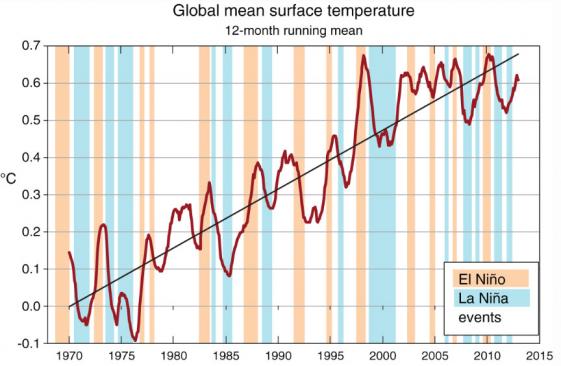Things are heating up on the global warming front. In New
York City on September 21st, hundreds of thousands of people from
across the US and around the world will gather together to make an un-ignorable
demand that world leaders at the following UN Climate Summit act faster and
more decisively to reverse the growth in greenhouse gas emissions. Meanwhile, I
have a friend walking across America as part of the Great March for Climate Action, and I’ve been invited to give more Climate Reality presentations in my
local community.
Of course, there are entrenched interests who want to expand
our self-defeating fossil-driven economy for their own selfish gain, so
naturally they are beating the drum of climate denial. Last week Lorne Gunter trumpeted a study by an economist in a pay-to-publish Chinese journal which
supposedly refutes global warming, showing the past couple of decades have had
a relatively stable temperature. Now, stable is hardly the word I would use to
describe the weather weirdness we’ve seen over the past decade, but I guess economists
see things differently.
But it’s a weak argument. There is no denying our climate has
warmed significantly over the past century, as our growing population’s land
and energy use have altered the chemistry of our atmosphere. The past 354
months, without exception, have all been warmer than the 20th
century average. That means that anyone born since February 1985 has never, in
their whole entire life, ever experienced a month that was at or below global
average temperatures.
 |
| Pick two points at the same height and call it a "pause". Who cares about the bigger trend? |
This supposed “pause” only appears when you cherry-pick your end points and focus solely on surface temperatures that under-sample arctic
regions, and totally ignore the actions of the world’s oceans, a major heat
sink. It’s expected for climate change to come in fits and starts, rather than
as a steady one-way trend, just as a road ascending a mountain has level or
even short downward stretches.
The key is to look at the wide range of indicators –
temperatures at the surface, in the high atmosphere, and in the oceans are a
start, but shifts in weather patterns (like floods and drought) are also
important, as are the responses of natural species. When you put those
together, the picture is quite clear – we are rapidly changing our climate in
unpredictable ways by adding more heat-trapping gases to our atmosphere.
It’s ironic that even climate deniers must admit the climate is
warming to give the term “pause” any meaning.
This whole politicization of climate change is unique to
English-speaking nations; in the rest of the world, the debate between left and
right isn’t whether our pollution is changing the climate, but how best to
address it. Even here, at the municipal level and among building and
infrastructure professions, climate change is a given.
Now is the time for the conversation on climate to shift from
debate and despair to determination and solutions. Accept no more fuddle-duddle
from our national leaders! This Tuesday, September 16th, you can
tune in to “24 Hours of Reality: 24 Reasons for Hope” at www.24HoursofReality.org and learn what is happening to our climate, and the
many existing tools we can activate, either individually, as communities, or as
a nation. We have the technology, let’s build the will and the movement to use
it!
Published as my Root Issues column in the Barrie Examiner as "Reversing the growth in greenhouse gas emissions"
Erich Jacoby-Hawkins is
a certified member of the Climate Reality Leadership Corps.
No comments:
Post a Comment